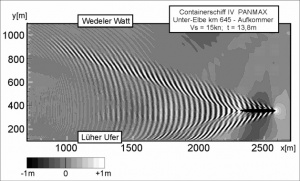Hydrodynamic Numerical Methods
From BAWiki

Through use of the presently available computer hardware and a new form of the BOUSSINESQ equation describing the spreading of shallow wind generated water waves (NWOGU, 1993)[1], it was possible to simulate ship waves in laterally and depth limited waterways where the wave effects of refraction, shoaling, diffraction, reflection and most recently also current refraction as well as squat and trim (albeit at subcritical speed to date) could be included. Extensive calculations using the WAKE2D numerical model of the National Research Council of Canada - Canadian Hydraulic Center (NRC-CHC, 1997) [2]were commissioned by the BAW-DH as part of an investigation of the Lower Elbe river. The results of the WAKE2D calculations show that the amplitudes of the short period waves are estimated to be much higher than those measured in the physical model.
Other theoretical numerical methods for modeling currents around ships such as FANKAN (Fluid-Automaten-Net for Canals for large blockage factor ships; PAGEL/FÜHRER, 1989)[3]are not so far developed that they accurately discretize hydrodynamically optimized ship forms (e.g., a bulb-bow) and thus falsify the dynamic loading of sea waterways.
Preliminary results using another model called SHALLOWTANK (CHEN, 1998)[4] (CHEN/ULICZKA, 1999)[5] show qualitative, and to a certain degree, quantitative agreement with the measurements of ship runs acquired in the physical model of the BAW-DH. The SHALLOWTANK model has already been used for calculating ship induced loading for trans- and supercritical ship speeds (CHEN, 1997)[6]. It is conceivable that this program could be applied for calculating ship induced loading of inhomogeneous waterways when the necessary verification calculations for a validation have been performed.
The WAKE2D and SHALLOWTANK models are "state-of-research" but are still somewhat scientifically controversial tools for studying ship-sea waterway interaction.
A reliable quantitative prognosis for ship induced loading of sea waterways can presently only be obtained using properly scaled physical models.
References
- ↑ NWOGU, O., Alternative form of Boussinesq equation for nearshore wave propagation, J. of Waterway, Port, Coastel and Ocean Engineering, Vol. 119, No. 6, ASCE, USA, 1993
- ↑ NRC-CHC, Numerical Model Study of Ship-Induced Waves und Currents in the Elbe Estuary, Controlled Technical Report, HYD.CTR-093 (unpublished), Ottawa, Canada, 1997
- ↑ PAGEL, W. und FÜHRER, M., Umströmungs- und Widerstandsverhalten völliger Schiffe bei Kanalfahrt. Ergebnisse einer diskreten Modellierung und ihrer experimentellen Verifizierung, Mitteilungen der Forschungsanstalt für Schiffahrt, Wasser- und Grundbau, Schriftenreihe Heft 3, Berlin, 1989
- ↑ CHEN, X.-N., Schiffswellenbildung über einer querveränderlichen Topographie, Abstracts - 19. Duisburger Kolloquium Schiffstechnik/ Meerestechnik, Das Schiff für überkritische Fahrt, Duisburg, 1998
- ↑ CHEN, X.-N. und ULICZKA, K., On Ships in Natural Waterways, Proceedings of Int. Conf. on Coastal Ships and Inland Waterways, The Royal Institution of Naval Architects, Feb. 1999, London 1999
- ↑ CHEN, X.-N., Theoretische Grundlagen der Wellenwiderstandseliminierung bei überkritischer Fahrt, besonders durch den Einsatz gekrümmter Katamarane, Proceedings - 18. Duisburger Kolloquium Schiffstechnik/Meerestechnik, Das Schiff in begrenzten Gewässern, Duisburg, 1997
back to Ship-generated Loading
